6 Specifications
6.1 Absolute Maximum Ratings
over operating free-air temperature range (unless otherwise noted) (1)(2)
|
MIN |
MAX |
UNIT |
| VS |
|
±6.75 |
V |
| IOUT |
|
See(3) |
|
| Common mode input voltage |
|
V− to V+ |
V |
| Maximum junction temperature |
|
150 |
°C |
| Storage temperature |
−65 |
150 |
°C |
| Soldering information |
Infrared or convection (20 s) |
|
235 |
°C |
| Wave soldering (10 s) |
|
260 |
°C |
(1) Stresses beyond those listed under
Absolute Maximum Ratings may cause permanent damage to the device. These are stress ratings only, which do not imply functional operation of the device at these or any other conditions beyond those indicated under
Recommended Operating Conditions. Exposure to absolute-maximum-rated conditions for extended periods may affect device reliability.
(2) If Military/Aerospace specified devices are required, please contact the TI Sales Office/ Distributors for availability and specifications.
(3) The maximum output current (IOUT) is determined by device power dissipation limitations.
6.2 ESD Ratings
|
VALUE |
UNIT |
| V(ESD) |
Electrostatic discharge |
Human-body model (HBM), per ANSI/ESDA/JEDEC JS-001(1) |
±2000 |
V |
| Machine Model (MM), per JEDEC specification JESD22-C101, all pins(2) |
±200 |
(1) Human body model: 1.5 kΩ in series with 100 pF. JEDEC document JEP155 states that 2000-V HBM allows safe manufacturing with a standard ESD control process. Manufacturing with less than 2000-V HBM is possible with the necessary precautions. Pins listed as ±2000 V may actually have higher performance.
(2) Machine model: 0 Ω in series with 200 pF. JEDEC document JEP157 states that 200-V MM allows safe manufacturing with a standard ESD control process. Manufacturing with less than 200-V MM is possible with the necessary precautions. Pins listed as ±200 V may actually have higher performance.
6.3 Recommended Operating Conditions
over operating free-air temperature range (unless otherwise noted)(1)
|
MIN |
MAX |
UNIT |
| Operating temperature |
−40 |
85 |
°C |
| Nominal supply voltage |
±4 |
±6 |
V |
(1) Absolute Maximum Ratings indicate limits beyond which damage to the device may occur. Operating Ratings indicate conditions for which the device is intended to be functional, but specific performance is not ensured. For ensured specifications, see the Electrical Characteristics tables.
6.4 Thermal Information
| THERMAL METRIC(1) |
LMH6702 |
UNIT |
| DBV (SOT-23) |
D (SOIC) |
| 5 PINS |
8 PINS |
| RθJA |
Junction-to-ambient thermal resistance |
182 |
133 |
°C/W |
| RθJC(top) |
Junction-to-case (top) thermal resistance |
139 |
79 |
°C/W |
| RθJB |
Junction-to-board thermal resistance |
40 |
73 |
°C/W |
| ψJT |
Junction-to-top characterization parameter |
28 |
28 |
°C/W |
| ψJB |
Junction-to-board characterization parameter |
40 |
73 |
°C/W |
(1) For more information about traditional and new thermal metrics, see the
Semiconductor and IC Package Thermal Metrics application report (
SPRA953).
6.5 Electrical Characteristics
at AV = 2, VS = ±5 V, RL = 100 Ω, RF = 237 Ω (unless otherwise noted)(1)
| |
PARAMETER |
TEST CONDITIONS |
MIN(3) |
TYP(4) |
MAX(3) |
UNIT |
| FREQUENCY DOMAIN PERFORMANCE |
| SSBWSM |
-3-dB Bandwidth |
VOUT = 0.5 VPP |
|
1700 |
|
MHz |
| SSBWLG |
VOUT = 2 VPP |
|
720 |
|
| LSBWLG |
VOUT = 4 VPP |
|
480 |
|
| SSBWHG |
VOUT = 2 VPP, AV = +10 |
|
140 |
|
| GF0.1dB |
0.1-dB gain flatness |
VOUT = 2 VPP |
|
120 |
|
MHz |
| LPD |
Linear phase deviation |
DC to 100 MHz |
|
0.09 |
|
deg |
| DG |
Differential gain |
RL =150 Ω, 3.58 MHz |
|
0.024% |
|
|
| RL =150 Ω, 4.43 MHz |
|
0.021% |
|
| DP |
Differential phase |
RL = 150 Ω, 3.58 MHz |
|
0.004 |
|
deg |
| RL = 150 Ω, 4.43 MHz |
|
0.007 |
|
| TIME DOMAIN RESPONSE |
| tR |
Rise time |
2-V Step, TRS |
|
0.87 |
|
ns |
| 2-V Step, TRL |
|
0.77 |
|
| tF |
Fall time |
6-V Step, TRS |
|
1.70 |
|
ns |
| 6-V Step, TRL |
|
1.70 |
|
| OS |
Overshoot |
2-V Step |
|
0% |
|
|
| SR |
Slew rate |
6 VPP, 40% to 60%(2) |
|
3100 |
|
V/µs |
| Ts |
Settling time to 0.1% |
2-V Step |
|
13.4 |
|
ns |
| DISTORTION AND NOISE RESPONSE |
| HD2L |
2nd Harmonic distortion |
2 VPP, 5 MHz(7) (SOT-23) |
|
−100 |
|
dBc |
| 2 VPP, 5 MHz(7) (SOIC) |
|
−87 |
|
| HD2 |
2VPP, 20 MHz(7) (SOT-23) |
|
−79 |
|
dBc |
| 2VPP, 20 MHz(7) (SOIC) |
|
−72 |
|
| HD2H |
2VPP, 60 MHz(7) (SOT-23) |
|
−63 |
|
dBc |
| 2VPP, 60 MHz(7) (SOIC) |
|
−64 |
|
| HD3L |
3rd Harmonic distortion |
2VPP, 5 MHz(7) (SOT-23) |
|
−96 |
|
dBc |
| 2VPP, 5 MHz(7) (SOIC) |
|
−98 |
|
| HD3 |
2VPP, 20 MHz(7) (SOT-23) |
|
−88 |
|
dBc |
| 2VPP, 20 MHz(7) (SOIC) |
|
−82 |
|
| HD3H |
2VPP, 60 MHz(7) (SOT-23) |
|
−70 |
|
dBc |
| 2VPP, 60 MHz(7) (SOIC) |
|
−65 |
|
| OIM3 |
IMD |
75 MHz, PO = 10dBm/ tone |
|
−67 |
|
dBc |
| VN |
Input referred voltage noise |
>1 MHz |
|
1.83 |
|
nV/√Hz |
| IN |
Input referred inverting noise current |
>1 MHz |
|
18.5 |
|
pA/√Hz |
| INN |
Input referred non-inverting noise current |
>1 MHz |
|
3.0 |
|
pA/√Hz |
| SNF |
Total input noise floor |
>1 MHz |
|
−158 |
|
dBm1Hz |
| INV |
Total integrated input noise |
1 MHz to 150 MHz |
|
35 |
|
µV |
| STATIC, DC PERFORMANCE |
| VIO |
Input offset voltage |
|
|
|
±1.0 |
±4.5 |
mV |
| -40 ≤ TJ ≤ 85 |
|
|
±6.0 |
| DVIO |
Input offset voltage average drift |
See(6) |
|
−13 |
|
µV/°C |
| IBN |
Input bias current |
Non-Inverting(5) |
|
|
−6 |
–15 |
µA |
| -40 ≤ TJ ≤ 85 |
|
|
–21 |
| DIBN |
Input bias current average drift |
Non-Inverting(6) |
|
+40 |
|
nA/°C |
| IBI |
Input bias current |
Inverting(5) |
|
|
−8 |
±30 |
µA |
| -40 ≤ TJ ≤ 85 |
|
|
±34 |
| DIBI |
Input bias current average drift |
Inverting(6) |
|
−10 |
|
nA/°C |
| PSRR |
Power supply rejection ratio |
DC |
|
47 |
52 |
|
dB |
| -40 ≤ TJ ≤ 85 |
45 |
|
|
| CMRR |
Common mode rejection ration |
DC |
|
45 |
48 |
|
dB |
| -40 ≤ TJ ≤ 85 |
44 |
|
|
| ICC |
Supply current |
RL = ∞ |
|
11.0 |
12.5 |
16.1 |
mA |
| -40 ≤ TJ ≤ 85 |
10.0 |
|
17.5 |
| MISCELLANEOUS PERFORMANCE |
| RIN |
Input resistance |
Non-Inverting |
|
1.4 |
|
MΩ |
| CIN |
Input capacitance |
Non-Inverting |
|
1.6 |
|
pF |
| ROUT |
Output resistance |
Closed Loop |
|
30 |
|
mΩ |
| VOL |
Output voltage range |
RL = 100 Ω |
|
±3.3 |
±3.5 |
|
V |
| -40 ≤ TJ ≤ 85 |
±3.2 |
|
|
| CMIR |
Input voltage range |
Common Mode |
±1.9 |
±2.2 |
|
V |
| IO |
Output current |
|
50 |
80 |
|
mA |
(1) Electrical Table values apply only for factory testing conditions at the temperature indicated. Factory testing conditions result in very limited self-heating of the device such that TJ = TA. No guarantee of parametric performance is indicated in the electrical tables under conditions of internal self-heating where TJ > TA. Min/Max ratings are based on production testing unless otherwise specified.
(2) Slew Rate is the average of the rising and falling edges.
(3) All limits are ensured by testing or statistical analysis.
(4) Typical numbers are the most likely parametric norm.
(5) Negative input current implies current flowing out of the device.
(6) Drift determined by dividing the change in parameter at temperature extremes by the total temperature change.
(7) Harmonic distortion is strongly influenced by package type (SOT-23 or SOIC). See Application Note section under
Harmonic Distortion for more information.
6.6 Typical Characteristics
TA = 25°C, VS = ±5 V, RL = 100 Ω, Rf = 237 Ω (unless otherwise noted)
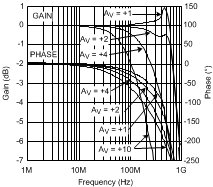
| V0 = 2 Vpp |
RL = 100 Ω |
RF = 237 Ω |
|
|
|
|
|
|
Figure 1. Non-Inverting Frequency Response
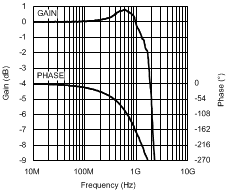
| VOUT = 0.5 VPP |
AV = 2 |
RF = 232 Ω |
|
|
|
|
|
|
Figure 3. Small Signal Bandwidth
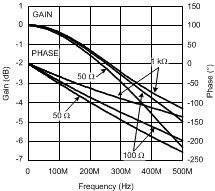
| AV = 4 |
VO = 2 VPP |
RF = 237 Ω |
|
|
|
|
|
|
Figure 5. Frequency Response for Various RLs, AV = 4
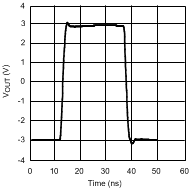
| AV = 2 |
VOUT = 6 VPP |
RL = 100 Ω |
|
|
|
|
|
|
Figure 7. Step Response, 6 VPP
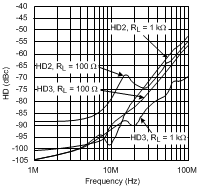 Figure 9. Harmonic Distortion vs Load and Frequency
Figure 9. Harmonic Distortion vs Load and Frequency
(SOIC Package)
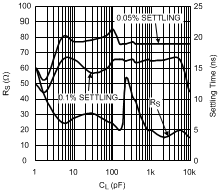 Figure 11. RS and Settling Time vs CL
Figure 11. RS and Settling Time vs CL
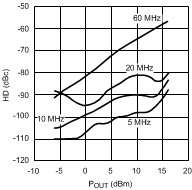
| AV = 2 |
RF = 237 Ω |
RL = 100 Ω |
|
|
|
|
|
|
Figure 13. HD3 vs Output Power (Across 100 Ω)
(SOIC Package)
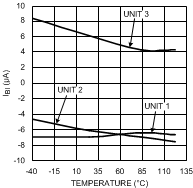 Figure 15. Inverting Input Bias
Figure 15. Inverting Input Bias
for 3 Representative Units
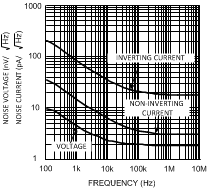 Figure 17. Noise
Figure 17. Noise
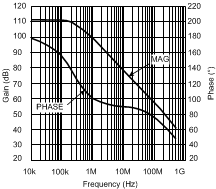 Figure 19. Transimpedance
Figure 19. Transimpedance
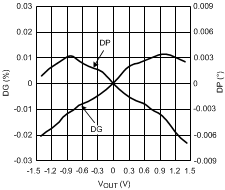 Figure 21. DG/DP (PAL)
Figure 21. DG/DP (PAL)
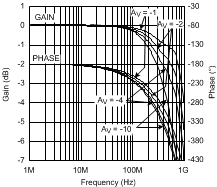
| VOUT = 2 VPP |
RF = 237 Ω |
RL = 100 Ω |
|
|
|
|
|
|
Figure 2. Inverting Frequency Response
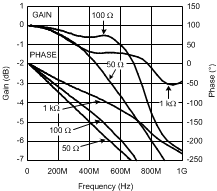
| AV = 2 |
VO = 2 VPP |
RF = 237 Ω |
|
|
|
|
|
|
Figure 4. Frequency Response for Various RLs, AV = 2
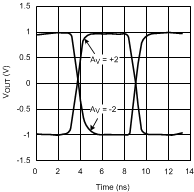 Figure 6. Step Response, 2 VPP
Figure 6. Step Response, 2 VPP
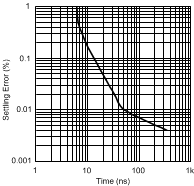 Figure 8. Percent Settling vs Time
Figure 8. Percent Settling vs Time
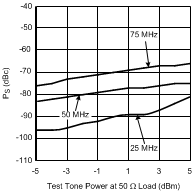
| AV = 2 |
RL = 100 Ω |
RF = 237 Ω |
|
|
|
|
|
|
Figure 10. 2 Tone 3rd Order Spurious Level
(SOIC Package)
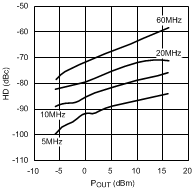
| AV = 2 |
RF = 237 Ω |
RL = 100 Ω |
|
|
|
|
|
|
Figure 12. HD2 vs Output Power (Across 100 Ω)
(SOIC Package)
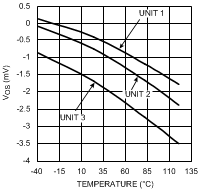 Figure 14. Input Offset for 3 Representative Units
Figure 14. Input Offset for 3 Representative Units
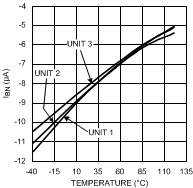 Figure 16. Non-Inverting Input Bias for 3 Representative Units
Figure 16. Non-Inverting Input Bias for 3 Representative Units
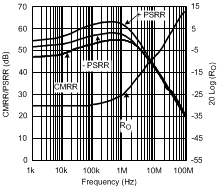 Figure 18. CMRR, PSRR, ROUT
Figure 18. CMRR, PSRR, ROUT
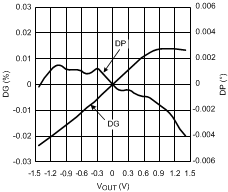 Figure 20. DG/DP (NTSC)
Figure 20. DG/DP (NTSC)




















